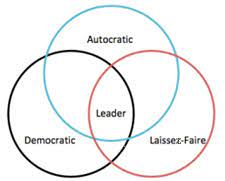Leadership styles can have a profound impact on the success of an organization. Each leadership style has its unique strengths and weaknesses, and understanding the differences between them is essential for effective leadership. In this article we explore the differences between authoritarian, democratic, and laissez-faire leadership styles and how they can impact the people being led.
Authoritarian Leadership Style
Authoritarian leadership is a style in which the leader has complete control over the decision-making process and the direction of the organization. This style of leadership is characterized by a strict hierarchy, and subordinates are expected to follow the directives of the leader without question.
One of the advantages of authoritarian leadership is that it can be effective in situations that require quick and decisive action, such as in emergency situations. However, this style of leadership can also be detrimental to morale and creativity within the organization. Leaders who adopt this style may also struggle to retain employees or followers, as their strict and inflexible approach can be demotivating.
Democratic Leadership Style
Democratic leadership is a style in which the leader seeks input and feedback from their subordinates before making decisions. This style of leadership is characterized by open communication and collaboration, and subordinates are encouraged to share their ideas and opinions.
One of the advantages of democratic leadership is that it can lead to a more engaged and committed workforce. When people feel that their voices are heard, they are more likely to be invested in the organization’s success. However, this style of leadership can also be time-consuming, and decision-making can be slower than in authoritarian leadership.
Laissez-faire Leadership Style
Laissez-faire leadership is a style in which the leader takes a hands-off approach and delegates decision-making to his/her subordinates. This style of leadership is characterized by a lack of direction and structure, and subordinates are expected to take the initiative and make decisions independently.
One of the advantages of laissez-faire leadership is that it can lead to increased innovation and creativity within the organization. When people are given the freedom to explore new ideas and approaches, they are more likely to identify new and innovative solutions. However, this style of leadership can also lead to confusion and lack of direction, and subordinates may struggle to work effectively without clear guidance from their leader.
Choosing the Right Leadership Style
Effective leadership requires a deep understanding of the strengths and weaknesses of each leadership style. There is no one-size-fits-all approach to leadership, and different situations may require different leadership styles.
For example, in emergency situations, authoritarian leadership may be necessary to make quick and decisive decisions. On the other hand, in situations that require creativity and innovation, a laissez-faire leadership style may be more effective. In most cases, a democratic leadership style that encourages collaboration and open communication can be effective in building an engaged and committed workforce.
It’s important to note that a leader’s personality and values can also impact their leadership style. Some leaders may naturally gravitate towards authoritarian leadership, while others may prefer a more collaborative approach. It’s important to be self-aware and reflect on your strengths and weaknesses as a leader to choose a leadership style that aligns with your values and personality.
In conclusion, understanding the differences between authoritarian, democratic, and laissez-faire (as well as other) leadership styles is essential for effective leadership. Each style has its unique strengths and weaknesses, and different situations may require different leadership styles. Effective leaders are self-aware and reflect on their values and personality to choose a leadership style that aligns with their strengths and the needs of their organization.
Thanks to my good friends at Kashbox Coaching for this article.

